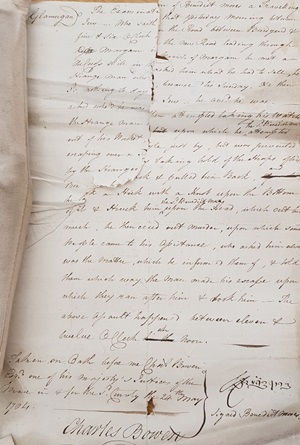History at Leicester
History of Sex and Crime in Wales
Dr Angela Muir discusses her research on the history of sex and crime in Wales during the long eighteenth century.
As a Canadian academic working at the University of Leicester who researches the social and cultural history of Wales in the long eighteenth century, the question I am asked most frequently is, ‘why Wales?’ My preferred answer is usually, ‘why not?’ The question often comes from a place of genuine curiosity, but at times, there are hints of a disparaging subtext implying this is a history not worth studying. I do wonder if I would be asked this were I an historian of Ireland, Scotland or England. Although undeniably tied to English history (and for 450 years, administratively part of England), Wales is not England. It has its own rich history worthy of researching in its own right, which can also contribute to greater knowledge of British, European and global history. That is the overall aim of my research.

I have been researching and writing about Welsh social and cultural history throughout my postgraduate studies and academic career. My doctoral research and subsequent book Deviant Maternity (Routledge, 2020) examined illegitimacy in Wales between 1680 and 1800. One of my main findings was that levels of illegitimacy (children born to parents who were not married to each other) was higher in some parts of Wales than in many parts of England due, in part, to certain cultural practices that allowed young couples to engage in premarital sex. This, combined with difficult economic circumstances meant that some pregnant couples could not marry, despite their best intentions. One of these cultural practices was a custom sometimes referred to as ‘bundling’, which involved a male suitor visiting the woman he was courting in her home at night, often unsupervised. I will leave it to you, dear reader, to connect the dots.
We have very few first-hand accounts of this custom, with most evidence coming from English travel writers who visited Wales when they could no longer go on the Grand Tour, or moral commentators who were appalled at the perceived immorality of the Welsh. However, my research has uncovered first-hand accounts of this in an unlikely place: witness depositions from the Court of Great Sessions, which was the highest criminal court in Wales between the 1540s and the 1830s. This is not because this practice was illegal, but because sometimes when courtships go horribly wrong they result in criminal prosecutions. This includes when one lover attempts (sometimes successfully) to kill the other, or a thwarted lover takes revenge through arson, or a former lover drunkenly pays a visit in the hopes of rekindling relations, only to mistakenly crawl through the master of the house’s bedroom window, rather than his intended lover’s. In these cases, narratives of courtship are revealed as part of the back-story that provides the context to a crime.

Depositions from the Great Sessions are an incredible source of evidence for a huge range of topics, including and beyond criminality. These records are held at the National Library of Wales in Aberystwyth, and I have blogged and given public talks for the Library about their scope and potential. Detailed narrative pre-trial depositions from the Great Sessions are now the focus of my current research projects. These include a co-written article about alternative uses of tobacco pipes (as weapons, catheters, etc.), histories of sex work (which was not technically a criminal offence), and most recently, my British Academy/Leverhulme Trust Small Grant project that explores diversity, identity and social change in Wales between 1730 and 1830. For this project, I analyse social conflict and interpersonal violence for evidence of changing sociability amongst the lower and middling classes of society. I am also mining these records for details about the identities of witnesses, defendants and prosecutors that illustrates the extent to which Wales was more culturally diverse and globally connected during this period than is often assumed. There is evidence of Black, Romani and Jewish people, as well as people from across Europe and North America. For example, in 1784 a Jewish pedlar named Benedict Moses was assaulted and robbed near Bridgend while he was selling his wares. His assailant was captured, convicted and sentenced to transportation. What is most compelling about Benedict’s deposition is that he signed it in elaborate Hebrew. We cannot know if this assault and robbery was motivated by antisemitism or just plain greed, but it is apparent that Benedict’s religious and ethnic identity marked him out in some way. His assailant commented on it, those who came to his rescue described him as a ‘travelling Jew’, and based on his elegant signature, Benedict’s Judaism was clearly an important part of his identity. Details like this demonstrate the immense potential of Great Sessions records for future research that has clear implications for Welsh history and beyond.